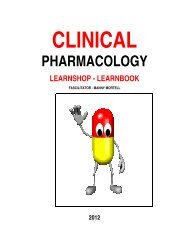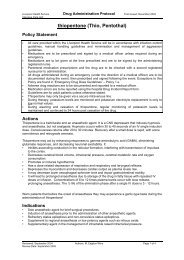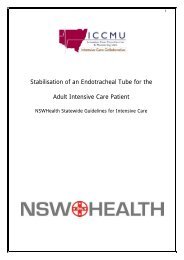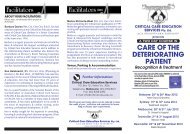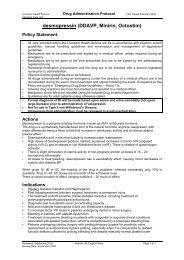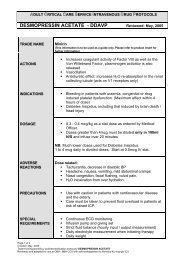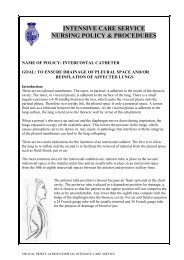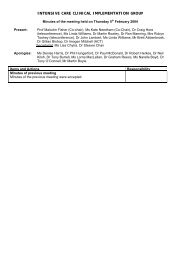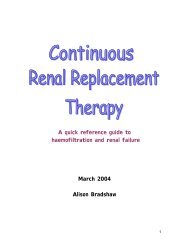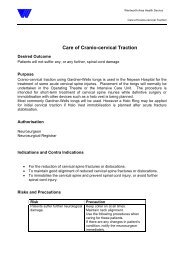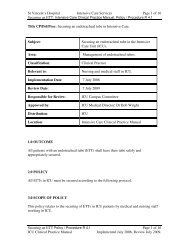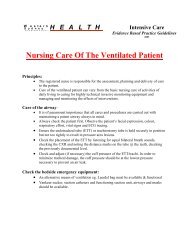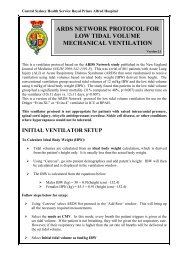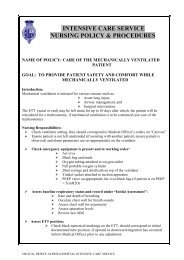CPAP (RPA) - Intensive Care & Coordination Monitoring Unit
CPAP (RPA) - Intensive Care & Coordination Monitoring Unit
CPAP (RPA) - Intensive Care & Coordination Monitoring Unit
You also want an ePaper? Increase the reach of your titles
YUMPU automatically turns print PDFs into web optimized ePapers that Google loves.
DISPOSAL OF EQUIPMENT:<br />
• <strong>CPAP</strong> machine is wiped down with mild detergent<br />
• The ventilation tubing, PEEP valve and humidifier chamber are disposable<br />
• All rubber connectors, hard plastic connectors and heating wires are sent to CSSD for<br />
sterilisation<br />
• <strong>CPAP</strong> mask and straps are cleaned with mild detergent<br />
REFERENCES:<br />
Bucher,L & Melander,S. (1999) Critical care nursing. W.B Saunders:Philadelphia<br />
Hill, N.S. (1997). Complications of non-invasive positive pressure ventilation. Respiratory <strong>Care</strong>, 42 (4) 433-441.<br />
Hotchkiss, J.R. & Marini, J.J. (1998). Non-invasive ventilation: An emerging supportive technique for the<br />
emergency department. Annals of Emergency Medicine, 32 (4) 470-479.<br />
Kannan, S. (1999). Practical issues in non-invasive positive pressure ventilation. <strong>Care</strong> of the Critically Ill, 15 (3)<br />
76-79.<br />
Knebel, A., Allen, M., McNemar, A. & Feigenbaum, K. (1997). A guide to non-invasive intermittent ventilatory<br />
support. Heart & Lung, 26 (4) 307-316.<br />
Mahamid, E. (2000). Non-invasive positive-pressure ventilation in acute respiratory failure. <strong>Care</strong> of the Critically<br />
Ill, 16 (2). 55-58.<br />
Marshall, A. & Pittard, M. Nursing the patient receiving Continuous Positive Airway Pressure Therapy. Australian<br />
Nurses Journal, Clinical Update. February 1998.<br />
Moore, M.J. & Schmidt, G.A. (2001). Keys to effective non-invasive ventilation, Part 1: Initial steps. Journal of<br />
Critical Illness, 16 (2) 64-70.<br />
Pierce, L.N.B. (1995). Guide to mechanical ventilation and intensive respiratory care. W.B. Saunders:<br />
Philadelphia.<br />
Py Ho, Rosa, & Boyle, M. (2000). Non-invasive positive pressure ventilation in acute respiratory failure: providing<br />
competent care. Australian Critical <strong>Care</strong>, 13 (4) 135-143.<br />
Oh, T. E. <strong>Intensive</strong> <strong>Care</strong> Mannual. Butterworths, 4 th ed. 2000.<br />
“Vital Signs” product information, 1992<br />
Occupational Health and Safety: Universal precautions taken in the preparation, administration of drug and<br />
disposal of equipment and sharps.<br />
Cross Referenced: <strong>RPA</strong>H Occ. Health & Safety Manual and Infection Control Manual<br />
NSW Infection Control Policy 98/99<br />
Revised by: Marianne O’Reilly CNS May 2003<br />
Reviewed by: Chanelle Innes CNC Cheryl Richards CNE<br />
Authorised by: Dr. Richard Totaro May 2003<br />
Revision: May 2005<br />
With the introduction of Powerchart online ordering, a clinical agreement has been set up with the Director<br />
of ICS and other Staff Specialists. Nursing Management, with the agreement of the hospital executive, have<br />
made arrangement that allows all permanently employed <strong>RPA</strong>H Nursing Staff to place orders for a variety of<br />
tests on their behalf. It is a Health Insurance Commission (HIC) directive that all orders placed by nursing<br />
staff are countersigned by the responsible MO within 14 days.<br />
©ROYAL PRINCE ALFRED HOSPITAL INTENSIVE CARE SERVICE



